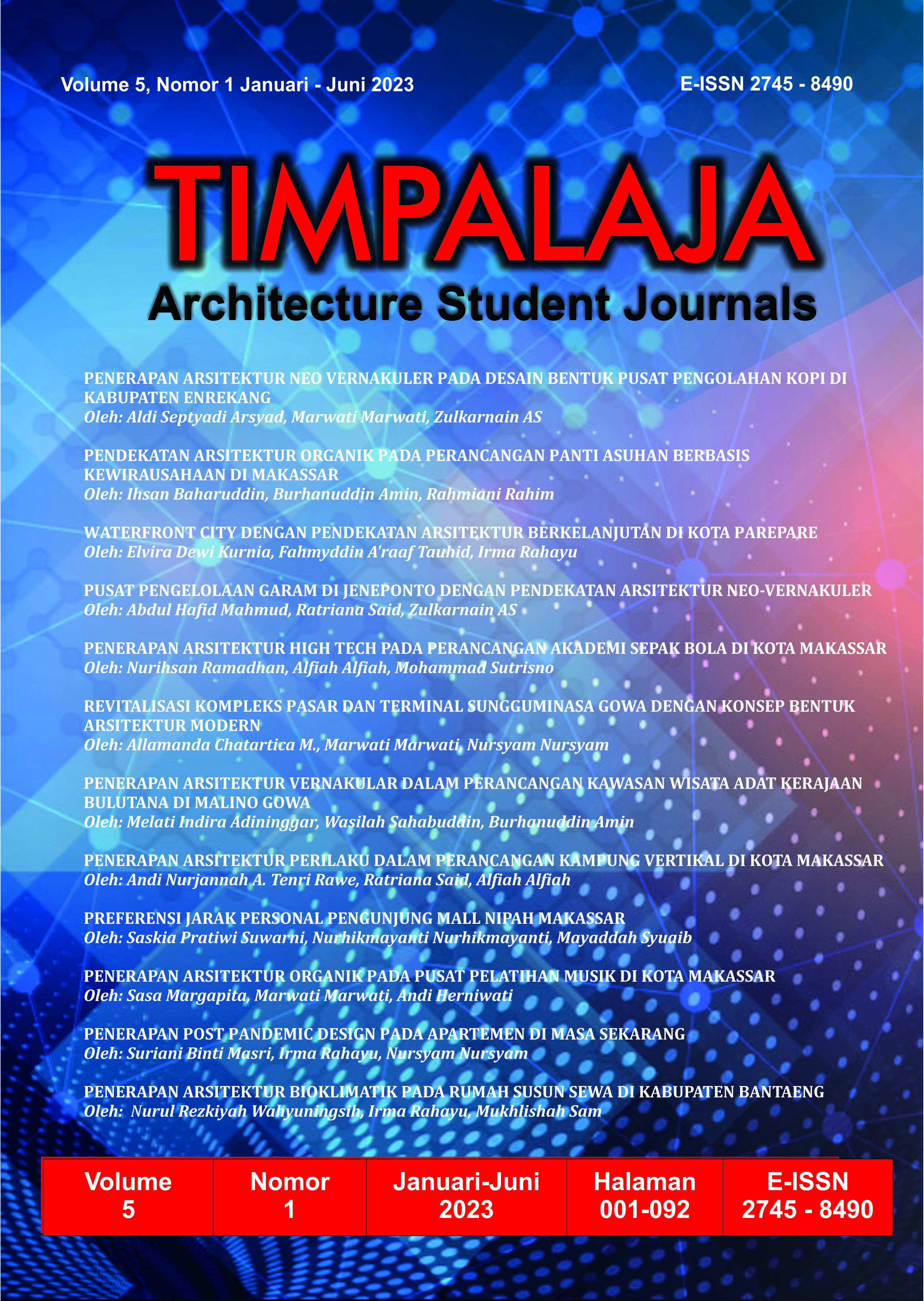Pusat Pengelolaan Garam di Jeneponto dengan Pendekatan Arsitektur Neo-Vernakuler
Abstract
In the salt industry sector, Jeneponto district, according to Badan Pusat Statistik (BPS)
Jeneponto has a land area of 622.66 Ha; the number of business units of 850 with a total workforce of 2,345 people and production results 21,316.00 tons. This is a great potential in the development of production. Salt is found in Indonesia, especially in South Sulawesi, and has cultural value. including in the form of traditional regional houses. So therefore, the building of the Salt Management Center in Jeneponto will refer to the approach neo-vernacular architecture in terms of philosophy and aesthetics of building forms with an area of 29,300 m2, the design of the Salt Management Center has several building facilities consisting of factory buildings, management offices, mosque, and cafeteria, including parking, a garden, and a field. Component the structure applies a wide span
structure, namely, from the bottom structure there is tread and sloof foundations; the middle structure consists of walls, columns, and ringbalk. The superstructure applies the roof structure of cremona, or better known as steel pipe frame structure. The choice of form philosophy in traditional houses Jeneponto (Balla Kambara) with a neo-vernacular architectural approach is expected to be an effort to preserve local culture, especially in Jeneponto. On the other hand, in terms of Islamic values, it is expected that Cultural influences will not be separated from regional identity and will always be bound in one unity.
References
BPS Kabupaten Jeneponto. (2017). Kabupaten Jeneponto Dalam Angka (Jeneponto Regency In Figures), Jeneponto : BPS Kabupaten Jeneponto.
Mustofa. Turjono, Edy. (2015). Analisis Optimalisasi Terhadap Aktivitas Petani Garam Melalui Pendekatan Hulu Hilir Di Penambangan Probolinggo, 46-57.
Azis, Hidayat. (2017). Strategi Pengelolaan Produksi Garam di Kecamatan Arungkeke Kabupaten Jeneponto Provinsi Sulawesi Selatan, Tesis, Sekolah Pascasarjana Institut Pertanian Bogor, 15-71.
Sambo P, Rivaldy. (2017). Pengelolaan Terpadu Tambak Garam Dan Artemia Di Kecamatan Bangkala Kabupaten Jeneponto, Tesis, Sekolah Pascasarjana Institut Pertanian Bogor, 1345.
George, Tegai. (2016). Teori Arsitektur Neo-Vernakular. 51-67.
Varson V, Chach. (2015). Kantor Gubernur Papua Barat Daya di Kota Sorong: Arsitektur NeoVernakular, Skripsi, Universitas Sam Ratulangi, 106-111.
Fajrine, Ghina dkk. (2017). Penerapan Konsep Neo-Nernakular pada Stasiun Pasar Minggu, Skripsi, Universitas Trisakti, 85-91.
Saputra, Rido dkk. (2017). Pusat Kebudayaan Minangkabau di Kota Padang dengan Pendekatan Arsitektur Neo-Vernacular, Skripsi, Universitas Riau, 1-8.
Neufert, Ernest.1996. Data Arsitek Jilid 1. Jakarta: Erlangga.
Neufert Ernest. 2002. Data Arsitek Jilid 2. Jakarta: Erlangga.
https://kbbi.web.id, diakses 18 Juli 2018.
https://ekonomi.kompas.com/read/2018/08/14/204555326/kebutuhan-garam-nasional-capai-42-jutaton-per-tahun, diakses 16 Mei 2019.
https://1.bp.blogspot.com/hpvuiawuou/wfpscxahi/aaaaaaaaacc/3tvyj1ogzou3dwxgt8xydfwiou0jrm2aclcb/s1600/img_0311.jpg, diakses 17 Mei 2019.
Copyright (c) 2023 Abdul Hafid Mahmud, Ratriana Said, Zulkarnain AS

This work is licensed under a Creative Commons Attribution-ShareAlike 4.0 International License.
By submitting your manuscript to our journal, you are following Copyright and License







